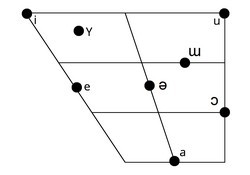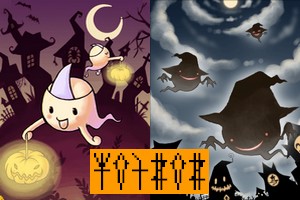This thread shall be about the griushkoent conlang and its associated world.griushkoent /'griuʃkɯnt/: Fictional language, agglutinative, SVO, trigger, head-final, alphabetic script, mixed fantasy
* https://reyzadren.neocities.org | * http://www.frathwiki.com/griushkoent

Get the test prep as a self-reference. Also, it is available on Lulu.
Student dictionary. Alternate link.
* Storybook: ykgloemae yoiz (Ghosts, translation). Link 2.
* Storybook: taloem (The Pearl, translation). Link 2.
* Storybook: klustespalven riounds (Paper menagerie, The sea king's second bride, translation etc).
* Storybook: lyrshi uazhae oelzhaezh (The giants of the violet sea, translation)
* Storybook: kyroelsouiram riounds (Seasons of glass and iron, Sunspots, translation etc).
* Storybook: souyi un ilz yuhi (Quietly and Very Fast, translation).
* Storybook: saedoeuartaegsh riounds (Sauerkraut station, Portrait of Lisane da Patagnia, translation etc).
* Storybook: marreps riounds (Mama we are Zhenya your son, The bookmaking habits of select species, translation etc).
* Storybook: oendslung (The waiting stars, 2 truths and a lie, translation).
* Storybook: vegler un roeter bruafsen (Strange case of Dr Jekyll and Mr Hyde, translation).
* Storybook: draeizhyehkuthplud (Christmas carol, translation). Link 2.
* Storybook: sougel ual (The sign of four, translation).
* Storybook: naib un er (Of mice and men, translation).
* Storybook: toekam (Pymalion, translation).
* Storybook: shadzysh (Tempest, translation).
* Storybook: caus kayoec (hiodel) (The lord of the rings, The two towers, book 4 translation).
* Storybook: ijfenslef riounds (general fiction). Link 2.
* Storybook: krelsneyot (general fiction). Link 2.
* Storybook: thuzhgjaevvazhen riounds (general fiction). Link 2.
* Storybook: stihkuja prab (general fiction). Link 2.
* Storybook: daezhkiroe (general fiction).
* Storybook: degs gaeirae (general fiction).
* Storybook: soigjilk riounds (general fiction)
* Storybook: zhevesmoezon riounds (general fiction)
* Storybook: narou lash (general fiction; pictures).
* Storybook: vurshzuik riounds (general fiction)
* Storybook: yavklez riounds (general fiction)
* Storybook: Nebula Awards 2021~2023 translation
* Auxiliary study: High school syllabus. Link 2.
* Auxiliary study: aronszag
* Auxiliary study: kegfesh blajs
* Auxiliary study: skuipzag
* Auxiliary study: xaroebzag
* Auxiliary study: blythzag
* Auxiliary study: perbduyaeij
* Auxiliary study: thaenvaeron
* Auxiliary study: diougelg
* Bilingual guide: Kaeloes Heroes
* Bilingual guide: Sentence Bank
* Bilingual guide: Quickmedic Quicktopic
* Bilingual guide: EO
* Bilingual guide: TP
* Audio: auryk jiska (reading passage)
* Audio: zaumsyaej (reading)
* Audio: aeskae syrt varan yoiz (reading)
* Audio: kleshorgluc (reading)
* Audio: uarkegor (reading)
* Audio: karbe (reading)
* Song: haezhgeth
* Song: eshpaerj
* Song: zaubar hethe
* Song: caeims
* Song: oth zidan vuzh zheg
* Song: shur az hin aesk
* Song: skuyaae vaezhon (ft. Khemehekis)
* Song: varushae uarzag
* Song: tibhaulen
* Song: arendaens
* Song: avas
* Song: uthzhaunendsa
* Song: sar saerpar thaf
* Song: zharfaun
* Song: shurvi yujonreb
* Song: shuryuji
* Song: maedshsi thafen
* Song: auzakroe
* Song: degs aeskae kluari aun (ft. Khemehekis)
* Song: uvus
* Song: rebin yujon (ft. Khemehekis)
* Song: aeskae saeth
* Song: rolkyr
* Song: yavralga
* Song: iaraishkigen (ft. Khemehekis)
* Website: Pages with the griushkoent script. Sample page [1] [2].
* Website: Various griushkoent images and their translations.
* Video game: griushkoent exploration.
* Video game: griushkoent ijlej.
Conworld information: Aseritonum country
--------------------
Phonology


There are 10 diphthongs that natively appear in griushkoent, though triphthongs can also be formed with gliding diphthongs.
/ai au ia iɔ iu ɔi ɔu ua ui ei/
* Phonotactics
(C)(C)(C)V(V)(V)(C)(C)(C) for each syllable, as a theoretical maximum. CCVVCC is the usual configuration.
Stress is always on the first syllable of each word.
Orthography

Griushkoent uses its own alphabetic script that has a regular phonemic orthography, which means that 1 grapheme corresponds to exactly 1 phoneme. This script has components of only straight lines without curves or dots. It is written from left to right, downwards.
* Romanisation (used on this forum)
p t k s b d g z m n ng sh w y x zh
/p t k s b d g z m n ŋ ʃ w j ɣ ʒ/
r c f h l j v th a i o u e ae y oe
/r tʃ f h l dʒ v θ a i ɔ u ə e Y ɯ/
Grammar
The parts of speech of griushkoent include nouns, verbs, adjectives and particles. The affixations encourage interconversions of word classes with suffixes, while morphological derivations are done with prefixes. The affixes can usually be re-used across classes: There are passive nouns, passive verbs and passive adjectives, eventhough such voice category is often related to verbs.
It has agglutinative morphology, with additive affixes and has no fusional processes.
Its morphosyntax is trigger. It has 3 main voices: active, passive and circumstantial. There is also the unstable circumstantial voice to denote far-field objects, and an anti-trigger to remove the effects of triggers.
* Affixes
[Suffixes]
Source /ə/
Empty box /ɔ/
Possessive /e/
Collective plural /s/
Verb class /a/
Passive voice /n/
Circumstantial voice /d/
Phasal TAM /t/
Imperative mood /r/
Adjective class /i/
[Prefixes]
Advanced /idʒ/
Reverse /əʃ/
Transitivity elevator /en/
Multi /Ys/
Inter /ɔv/
Intra /ɯz/
Anti /aʃ/
Pro /uθ/
* Additional notes
The empty box suffix does nothing, whereby it becomes a process or abstraction noun when interrupted by an imperative or passive suffix respectively.
The 3 triggers themselves must be crafted from a stable combination of susceptible affixes, via an affixation craftmanship system.
There are no adverbs, they are considered as adjectives in griushkoent.
Particles includes prepositions and conjunctions, as well as bound and unbound particles.
Syntax
SVOI structure is regularly used. In the passive voice, OV(S)(I) structure is used. With the circumstantial voice, the IV structure is utilised.
It has head-final directionality.
Reversors are analogous to passives, whereby they reverse the direction of information flow. Incidentally, though relative clauses and complements can be formed with a reversor, such "linguistical concepts" are regular descriptors.
There are other miscellanous related concepts: escapes, anti-escapes, pivots, anti-pivots, partitions, interaction ranges, stabilities, susceptiblities, priority rules etc.









